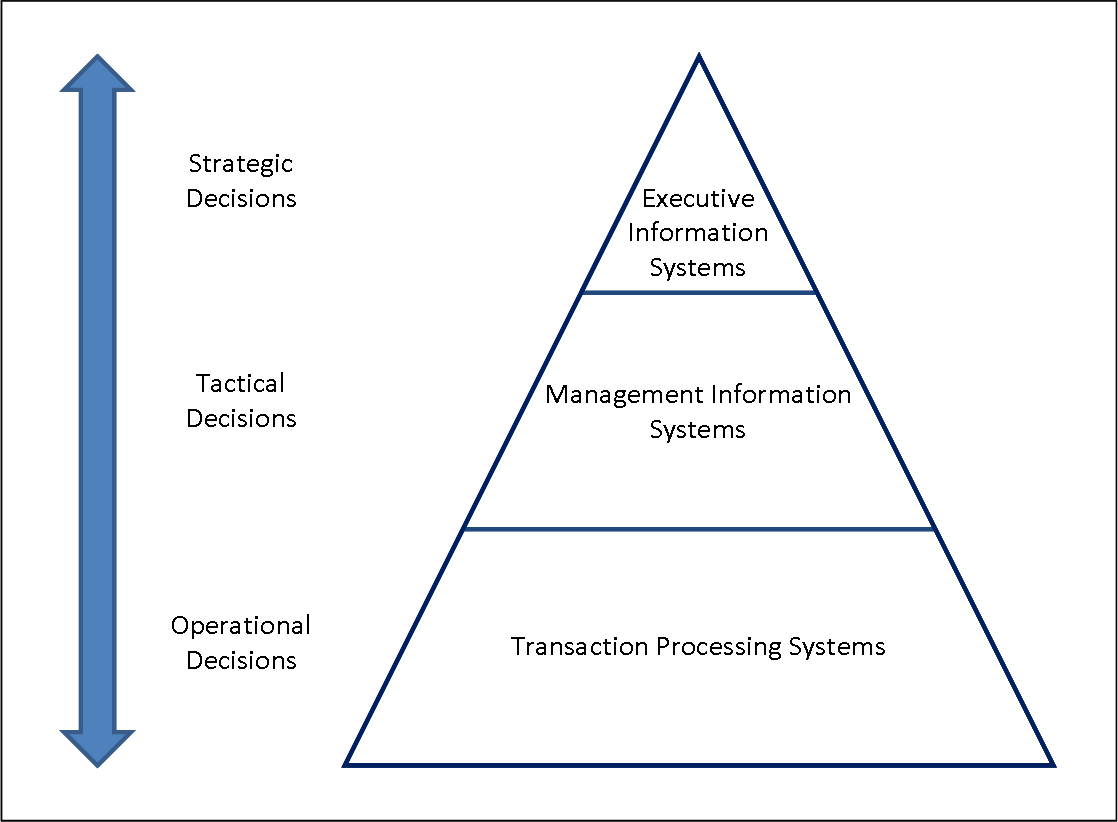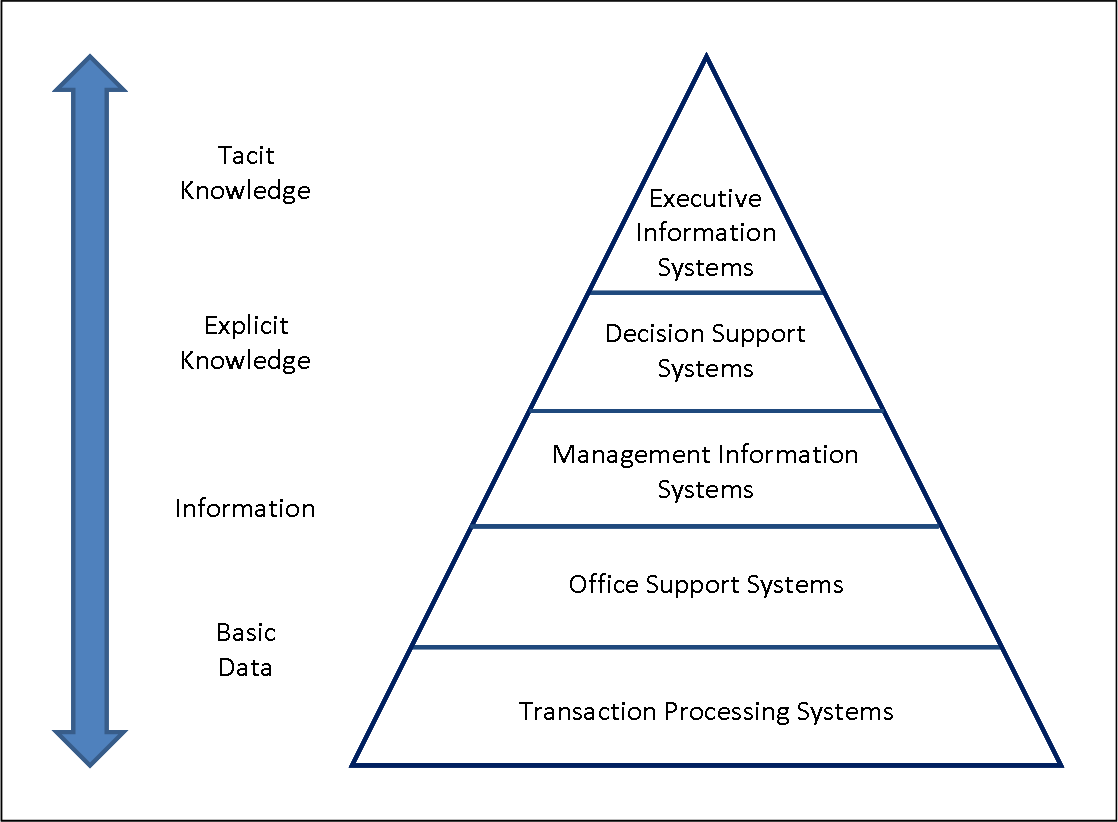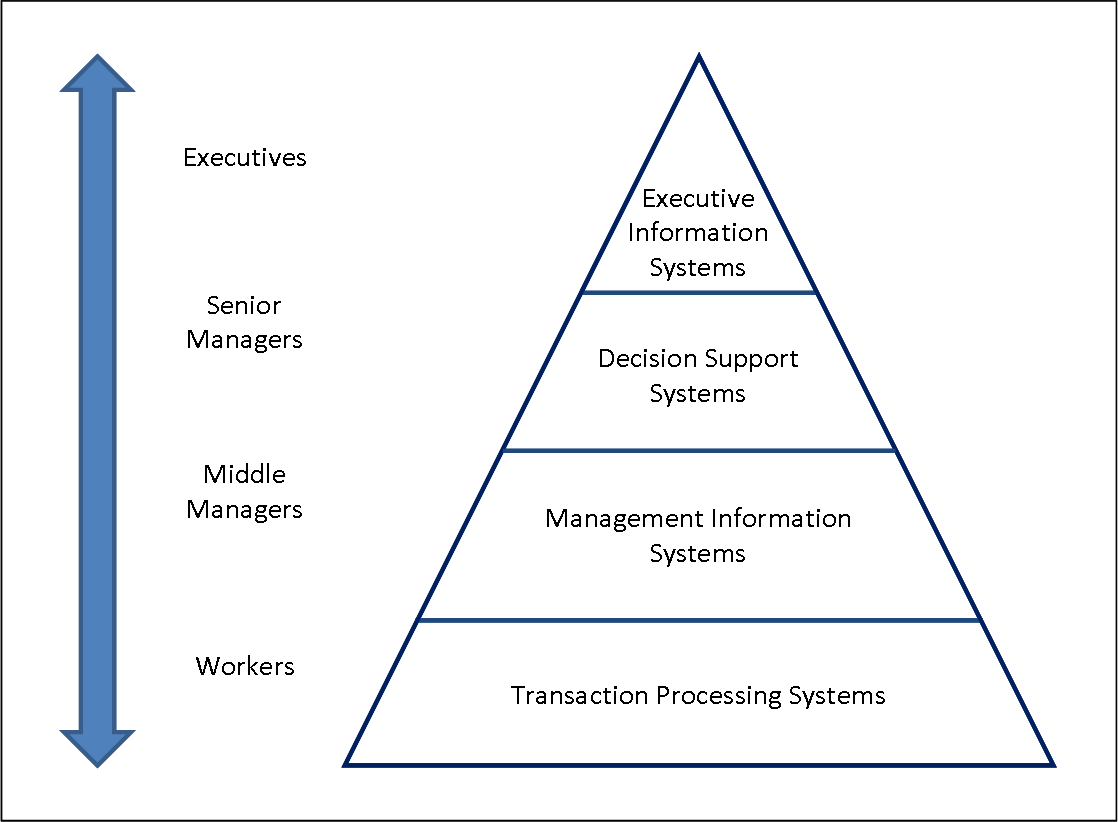
Euromed Marseille School of Management, World Med MBA Program - Information Systems and Strategy Course
You are here: Information Systems and Strategy, Session 1, Types of Information System and the Classic Pyramid Model
[Return to Session 1]
In the early days of computing, each time an information system was needed it was 'tailor made' - built as a one-off solution for a particular problem. However, it soon became apparent that many of the problems information systems set out to solve shared certain characteristics. Consequently, people attempted to try to build a single system that would solve a whole range of similar problems. However, they soon realized that in order to do this, it was first necessary to be able to define how and where the information system would be used and why it was needed. It was then that the search for a way to classify information systems accurately began.
The different types of information system that can be found are identified through a process of classification. Classification is simply a method by which things can be categorized or classified together so that they can be treated as if they were a single unit. There is a long history of classification of things in the natural world such as plants or animals, however, Information systems are not part of the 'natural' world; they are created and acquired by man to deal with particular tasks and problems. The classification of information systems into different types is a useful technique for designing systems and discussing their application; it not however a fixed definition governed by some natural law. A 'type' or category of information system is simply a concept, an abstraction, which has been created as a way to simplify a complex problem through identifying areas of commonality between different things. One of the oldest and most widely used systems for classifying information systems is known as the pyramid model; this is described in more detail below.
As can be seen above, there is not a simple answer to this. Depending on how you create your classification, you can find almost any number of different types of information system. However, it is important to remember that different kinds of systems found in organizations exist to deal with the particular problems and tasks that are found in organizations. Consequently, most attempts to classify Information systems into different types rely on the way in which task and responsibilities are divided within an organization. As most organizations are hierarchical, the way in which the different classes of information systems are categorized tends to follow the hierarchy. This is often described as "the pyramid model" because the way in which the systems are arranged mirrors the nature of the tasks found at various different levels in the organization.
For example, this is a three level pyramid model based on the type of decisions taken at different levels in the organization.

Three level pyramid model based on the type of decisions taken at different levels in the organization
Similarly, by changing our criteria to the differnt types of date / information / knowledge that are processed at different levels in the organization, we can create a five level model.

Five level pyramid model based on the processing requirement of different levels in the organization
While there are several different versions of the pyramid model, the most common is probably a four level model based on the people who use the systems. Basing the classification on the people who use the information system means that many of the other characteristics such as the nature of the task and informational requirements, are taken into account more or less automatically.

Four level pyramid model based on the different levels of hierarchy in the organization
Using the four level pyramid model above, we can now compare how the information systems in our model differ from each other.
Transaction Processing System are operational-level systems at the bottom of the pyramid. They are usually operated directly by shop floor workers or front line staff, which provide the key data required to support the management of operations. This data is usually obtained through the automated or semi-automated tracking of low-level activities and basic transactions.
TPS are ultimately little more than simple data processing systems.
| Inputs | Processing | Outputs |
| Transactions Events |
Validation Sorting Listing Merging Updating Calculation |
Lists Detail reports Action reports Summary reports? |
For historical reasons, many of the different types of Information Systems found in commercial organizations are referred to as "Management Information Systems". However, within our pyramid model, Management Information Systems are management-level systems that are used by middle managers to help ensure the smooth running of the organization in the short to medium term. The highly structured information provided by these systems allows managers to evaluate an organization's performance by comparing current with previous outputs.
MIS are built on the data provided by the TPS
| Inputs | Processing | Outputs |
| Internal Transactions Internal Files Structured data |
Sorting Merging Summarizing |
Summary reports Action reports Detailed reports |
A Decision Support System can be seen as a knowledge based system, used by senior managers, which facilitates the creation of knowledge and allow its integration into the organization. These systems are often used to analyze existing structured information and allow managers to project the potential effects of their decisions into the future. Such systems are usually interactive and are used to solve ill structured problems. They offer access to databases, analytical tools, allow "what if" simulations, and may support the exchange of information within the organization.
DSS manipulate and build upon the information from a MIS and/or TPS to generate insights and new information.
| Inputs | Processing | Outputs |
| Internal Transactions Internal Files External Information? |
Modelling Simulation Analysis Summarizing |
Summary reports Forecasts Graphs / Plots |
Executive Information Systems are strategic-level information systems that are found at the top of the Pyramid. They help executives and senior managers analyze the environment in which the organization operates, to identify long-term trends, and to plan appropriate courses of action. The information in such systems is often weakly structured and comes from both internal and external sources. Executive Information System are designed to be operated directly by executives without the need for intermediaries and easily tailored to the preferences of the individual using them.
EIS organizes and presents data and information from both external data sources and internal MIS or TPS in order to support and extend the inherent capabilities of senior executives.
| Inputs | Processing | Outputs |
| External Data Internal Files Pre-defined models |
Summarizing Simulation "Drilling Down" |
Summary reports Forecasts Graphs / Plots |
Executive Information Systems tend to be highly individualized and are often custom made for a particular client group; however, a number of off-the-shelf EIS packages do exist and many enterprise level systems offer a customizable EIS module.
Euromed Marseille Ecole de Management, World Med MBA Programme - Information Systems and Strategy Course
[Return to Session 1]